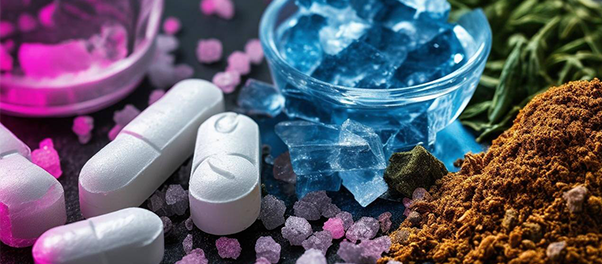Drug-Related Crime Statistics and Their Impact
Drug-related offenses are prevalent throughout the U.S. justice system, as evident in the state and federal prisons. According to the latest data:
- 134,000 people are incarcerated in state prisons for drug-related crimes.
- 68,000 federal inmates are held for drug-related offenses, emphasizing the centrality of drug crimes within the federal system.
- 97,000 individuals are detained in local jails for nonviolent drug-related offenses, indicating that drug-related arrests contribute heavily to pre-trial detention numbers.
Crimes Associated with Drugs
The overlap between drug involvement and other types of criminal activity is well-documented. Drug use can increase the likelihood of other offenses, especially those that are violent or property-related:
- Property Crimes: Individuals with substance use disorders may resort to theft, burglary, or fraud to fund their addiction.
- Public Order Offenses: Violations like driving under the influence and possession-related arrests contribute significantly to local jail populations.
- Weapons and Violent Crimes: Some drug markets are tied to violence, with 43,000 inmates held in state prisons for weapons-related crimes—many connected to drug distribution networks.
Do Drugs Contribute to Violence?
Some drugs are associated with increased aggression and violence. Research points to specific substances that can induce violent behavior:
- Stimulants: Drugs like methamphetamine and cocaine are known to heighten aggression and paranoia, which can lead to violent outbursts.
- Alcohol: Often overlooked, alcohol plays a significant role in violent crimes, including assaults and domestic violence.
- Synthetic Drugs: Substances like bath salts and synthetic cannabinoids (e.g., Spice or K2) have been linked to unpredictable and violent behavior.
Addressing Drug Crime and Incarceration
Addressing the high incarceration rate for drug-related crimes requires comprehensive reform efforts. These include:
- Alternatives to Incarceration: Expanding access to substance abuse treatment programs rather than imposing lengthy prison sentences.
- Decriminalization: Shifting from criminal penalties for possessing small quantities to civil fines or mandatory treatment.
- Racial Disparity Reduction: Data shows that Black and Hispanic communities are disproportionately affected by drug laws. Policies aimed at eliminating racial bias in sentencing are essential.
Conclusion
The intersection of drug use, crime, and incarceration reflects profound challenges within the U.S. justice system. The persistent focus on criminalizing drug offenses continues to drive mass incarceration, disproportionately impacting minority communities. Addressing these issues requires shifting from punitive approaches to public health strategies, including access to treatment, decriminalization, and efforts to reduce racial disparities in sentencing. Without meaningful reforms, the cycle of addiction, incarceration, and reentry will continue to strain individuals, families, and communities. Actual progress lies in prioritizing prevention and rehabilitation over punishment, ensuring that the justice system promotes accountability and healing.






















